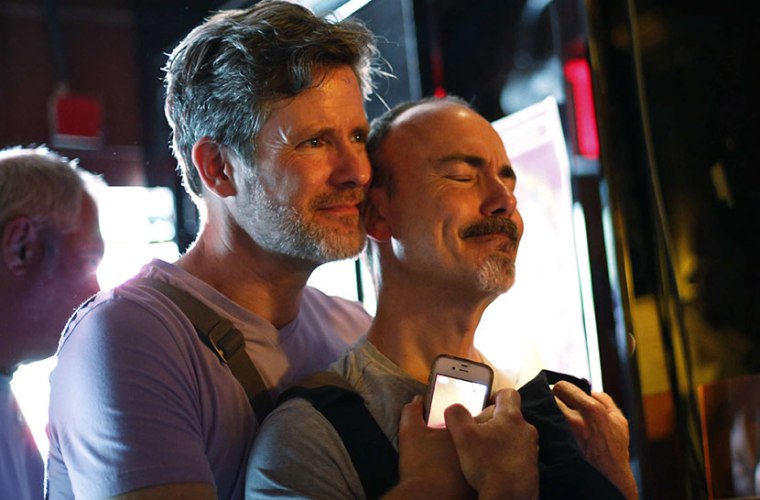Given the months of hype, it might seem hard to believe Wednesday's Supreme Court gay marriage decision is even more consequential than anyone had anticipated. But it is. It doesn’t just strike down the Defense of Marriage Act (DOMA), but it draws a detailed road map for courts to hold that same-sex marriage is a constitutional right nationwide.
That’s one reason why same-sex marriage advocates are celebrating—and why Justice Antonin Scalia, seeing the writing on the wall, issued what was even by his standards a fire-breathing dissent. The majority decision by Justice Anthony Kennedy, he wrote, is a “clumsy,” “confusing” mess of “legalistic argle-bargle” and “nonspecific hand-waving.” And it can only lead to one thing, in Scalia’s opinion: A decision from the high court in the next few years making all 50 states recognize same-sex marriages.
“The view that this Court will take of state prohibition of same-sex marriage is indicated beyond mistaking in today’s opinion,” he wrote. “No one should be fooled; it is just a matter of listening and waiting for the other shoe.”
Scalia may well be right.
The court’s opinion in United States v. Windsor is not, on its face, about whether gay couples have a constitutional right to marry under state law. It is about a different and narrower issue: Can the federal government define marriage for federal purposes as between a man and a woman, as DOMA did?
In a 5-4 decision split along ideological lines, the court said no and struck down DOMA as unconstitutional. That decision is deeply significant in its own right—it means same-sex married couples now have the same privileges as their opposite-sex counterparts under thousands of federal statutes and regulations.
But in the course of explaining why he was invalidating DOMA, Justice Kennedy’s majority opinion went much further—it offered passage after passage that reads like it was lifted straight from an opinion holding that same-sex marriage is a constitutional right. Consider:
- States that legalized same-sex marriage have “decided that same-sex couples should have the right to marry and so live with pride in themselves and their union and in a status of equality with all other married persons.”
- Differentiating between gay couples and straight couples “demeans the [gay] couple, whose moral and sexual choices the Constitution protects.”
- DOMA’s refusal to recognize same-sex marriages “places same-sex couples in an unstable position of being in a second-tier marriage” and “humiliates tens of thousands of children now being raised by same-sex couples.”
- The law’s “principal purpose is to impose inequality,” not to accomplish other goals “like government efficiency.”
- The law was motivated by “a bare congressional desire to harm a politically unpopular group.”
Same-sex marriage supporters can wield these statements, and many others in Kennedy’s opinion, to level a triple-barreled attack in future cases.
First, they can say, the Supreme Court has now made clear that the Constitution protects a gay couple’s “moral . . . choices.” Second, they can point out, the Supreme Court has held that there is no rational reason to differentiate between gay and straight couples—a critical piece of the legal test in deciding whether same-sex marriage is a constitutional right. And third, they can argue that the Supreme Court has already rejected one of the key arguments of same-sex-marriage opponents—that same-sex marriage harms children. Quite the contrary, they can argue, the Supreme Court has established that a lack of same-sex marriage harms children by “humiliat[ing]” children being raised by same-sex couples.
Same-sex marriage proponents certainly won’t overlook this legal gold mine.
Nor did the court’s conservatives miss the significance of Kennedy’s rhetoric. But they took two different tacks in combating it.
Chief Justice Roberts wrote a short dissent explaining hopefully that the points Kennedy made did not apply to a broader right to same-sex marriage. “The analysis leads no further,” he wrote. “The Court . . . does not decide” whether the states “may continue to utilize the traditional definition of marriage.”
Scalia went with the polar-opposite approach: He explicitly predicted that the court will make same-sex marriage a constitutional right, and he accused Kennedy of “deliberately” planting the seeds for that ruling.
The majority, he wrote, had concluded that “DOMA is motivated by bare . . . desire to harm couples in same-sex marriages. How easy it is, indeed how inevitable, to reach the same conclusion with regard to state laws denying same-sex couples marital status.” He predicted that the “second, state law shoe” will be “dropped”—in other words, that the court will go all the way and make same-sex marriage a national right—“later, maybe next Term.”
Same-sex marriage supporters everywhere no doubt are hoping, for once, that Scalia proves correct.
